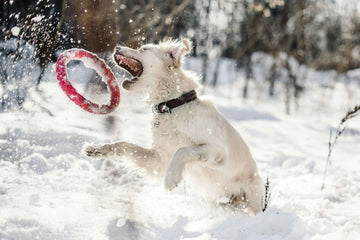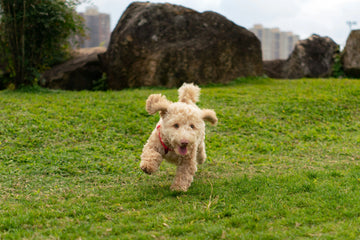On a sunny afternoon, while walking your furry friend in the park, you suddenly notice their back hair standing straight up, like a small brush. You might wonder: What's wrong with my dog? Are they angry? Are they going to attack someone?
In fact, dogs raising their hackles is a very natural physiological response, similar to when humans get goosebumps. From ancient wolves to modern domestic dogs, this behavior has been part of canine evolution.
Today, let's delve into this interesting and mysterious phenomenon and understand what our furry friends are trying to tell us through their raised hackles.

What Are Dog Hackles?
Dog hackles, professionally known as "piloerection," refers to the phenomenon where hair along the spine from neck to tail suddenly stands up. This response is similar to human goosebumps when we're scared or nervous - it's an involuntary physiological response controlled by the sympathetic nervous system.
Interestingly, dogs can't consciously control this hair-raising response, just like humans can't control their goosebumps. It's part of their natural instincts and often reflects their current emotional state.

Types of Hackle Raising
Based on the range and pattern of raised hair, we can categorize dog hackles into several types:
1. Partial Neck Hackles
Hair raises only in the neck area, typically indicating alertness or mild tension.
2. Full Back Hackles
Hair stands up from neck to tail, often suggesting high tension or a threatening state.
3. Neck-Tail Separated Hackles
When hair rises at both neck and tail while the middle back remains normal, usually indicating both interest and caution.
4. Partial Back Hackles
Hair raises only in specific back areas, possibly responding to specific stimuli.

Why Do Dogs Raise Their Hackles?
Understanding these reasons can help us better comprehend and care for our furry friends. Here are the main aspects:
1. Emotional Responses
- Nervousness and Fear: When dogs feel unsafe or startled, they instinctively raise their hackles as a self-protection mechanism, often accompanied by pinned-back ears and lowered tail.
- Excitement and Anticipation: Some dogs may show partial hackle raising when seeing toys or preparing for walks, indicating positive excitement.
- Alertness and Caution: Dogs raise their hackles to enhance their alert state when sensing potential uncertainties, a natural survival instinct.
- Aggressive Emotions: When facing threats or protecting territory, dogs might raise all hackles along with growling and baring teeth, serving as an intimidating defensive posture.
2. Environmental Factors
- Unfamiliar Environments: When first visiting new places, dogs might temporarily raise their hackles due to feeling insecure, a natural response to adapting to new environments.
- Unusual Sounds: Sudden noises like thunder, firecrackers, or car horns can trigger hackle raising, stemming from their sensitive hearing system.
- Potential Threats: Dogs' excellent sense of smell allows them to detect potential dangers we can't notice, and hackle raising is their way of expressing warning.
- Weather Changes: Some sensitive dogs might raise their hackles during sudden temperature or humidity changes, related to their temperature regulation mechanism.
3. Social Interactions
- Meeting Strange Dogs: When encountering unfamiliar dogs, they might raise their hackles to establish presence, a form of social communication.
- Territorial Awareness: Hackles might raise when other animals or people enter their perceived territory, reflecting strong territorial instincts.
- Playful Excitement: During play with companions, some dogs might briefly raise their hackles due to excitement, usually accompanied by happy barking and active body movements.
How to Properly Respond to Raised Hackles?
When you notice your dog's hackles are raised, here are some recommended responses:
1. Stay Calm
The owner's emotions directly affect the dog, so maintaining calmness is priority.
2. Observe the Environment
Quickly scan surroundings to identify potential causes of hackle raising.
3. Redirect Attention
- Use command words to redirect attention
- Guide the dog to perform familiar actions
- Use treats as appropriate rewards
4. Avoid Stimuli
If specific stimuli caused the hackle raising, promptly remove the dog from the situation.

Interesting Scientific Facts
Hackle raising isn't unique to dogs - it's an evolutionary trait shared by many animals. From house cats to lions, and even porcupines, many animals use this mechanism to appear larger and either intimidate enemies or express emotions.
The mechanism works through arrector pili muscles beneath the skin. These tiny muscles attached to hair follicles contract when stimulated by the nervous system, causing hair to stand up. This process traps air between the hairs, making the dog appear larger and more imposing.

Frequently Asked Questions
Q1: How long do raised hackles last?
A: Usually, hackles return to normal shortly after the stimulus disappears, typically lasting from seconds to minutes.
Q2: Does hackle raising always indicate aggression?
A: Not necessarily. Raised hackles can represent various emotional states, including excitement, curiosity, or nervousness, requiring comprehensive interpretation with other body language.
Q3: Should frequent hackle raising be medically examined?
A: If dogs frequently raise hackles in calm environments, consulting a veterinarian is recommended as anxiety or other health issues might be present.
Q4: What special considerations exist for puppies' hackle raising?
A: Puppy hackle raising often relates to insufficient socialization. This stage requires particular attention to positive guidance and adequate social opportunities.
Q5: What do different hackle raising patterns indicate?
A: According to animal behavior studies, narrower raising patterns usually indicate more confidence, while broader patterns might suggest greater insecurity.
Hackle raising is an important way dogs express emotions. As responsible pet parents, we must learn to "read" this language. Understanding various causes and manifestations of hackle raising helps us better care for our furry friends and build healthier, happier lives for them.
Finally, understanding dog hackle raising behavior not only helps us better care for them but also strengthens our emotional bond. After all, every subtle behavior conceals messages they want to convey to us. As their closest companions, we have both the responsibility and obligation to understand these silent signals.






